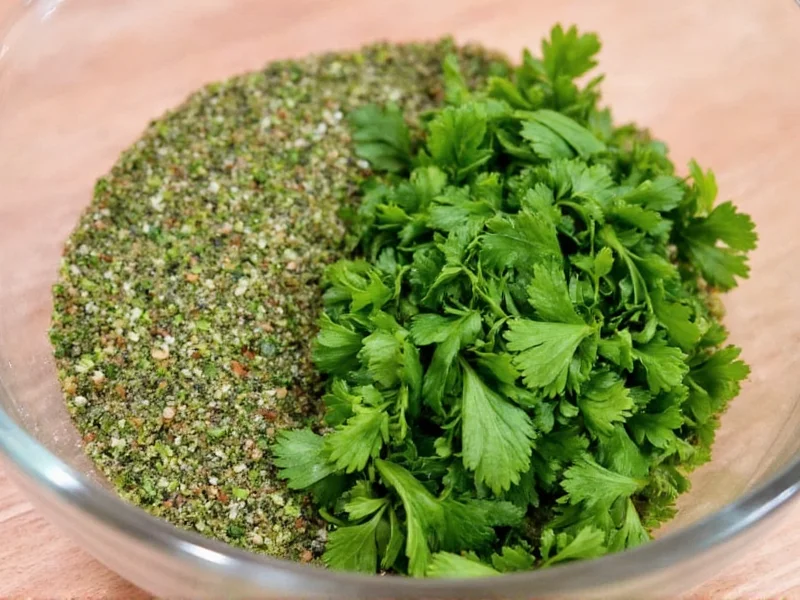Understanding Parsley Seasoning: More Than Just Dried Herbs
Parsley seasoning represents one of the most versatile dried herbs in culinary applications. While often overlooked in favor of flashier spices, this humble seasoning offers unique advantages for home cooks and professional chefs alike. Understanding its proper use can significantly elevate your cooking results.
The Science Behind Dried Parsley Flavor
When parsley undergoes the drying process, its chemical composition changes substantially. The volatile oils that give fresh parsley its bright, grassy character partially evaporate, resulting in a more concentrated but less complex flavor profile. Dried parsley develops earthier, slightly more bitter notes while retaining its essential herbal character.
The drying method significantly impacts quality. Air-dried parsley maintains better flavor integrity than heat-dried varieties, which can develop slightly burnt notes. High-quality parsley seasoning should appear vibrant green rather than dull brown, indicating proper processing and freshness.
Optimal Culinary Applications for Parsley Seasoning
Certain cooking techniques and dishes particularly benefit from parsley seasoning rather than its fresh counterpart:
- Long-simmering dishes: Soups, stews, and braises allow dried parsley's flavors to fully integrate
- Dry rubs and spice blends: Works better than fresh in rubs for meats and vegetables
- Baked goods: Ideal for savory breads, biscuits, and pastry fillings
- Sauces and gravies: Dissolves completely without textural issues
- Marinades: Penetrates proteins more effectively than fresh
| Dish Type | Recommended Amount | When to Add |
|---|---|---|
| Soups & Stews | 1-2 tsp per quart | Early in cooking |
| Sauces & Gravies | 1/2-1 tsp per cup | Middle of cooking |
| Dry Rubs | 1 tsp per 1/4 cup blend | Before application |
| Savory Baking | 1/2-1 tsp per cup flour | With dry ingredients |
Parsley Seasoning vs. Fresh Parsley: Key Differences
Understanding the distinctions between fresh and dried parsley prevents common culinary mistakes. Fresh parsley offers bright, grassy notes with subtle peppery undertones, while dried parsley develops earthier, more concentrated flavors with less complexity.
The texture difference significantly impacts usage. Fresh parsley provides visual appeal and textural contrast when used as a garnish, while dried parsley integrates completely into dishes. This makes dried parsley seasoning inappropriate for finishing dishes where visual presentation matters.
Proper Substitution Guidelines
Many home cooks struggle with converting between fresh and dried parsley. The standard culinary ratio is 1:3 - meaning you need one-third the amount of dried parsley compared to fresh. However, this ratio requires adjustment based on dish type and cooking time.
For dishes with short cooking times (under 30 minutes), use a 1:2.5 ratio. For long-simmering dishes (over 2 hours), a 1:3.5 ratio often works better as some flavor compounds break down over extended cooking.
When substituting dried for fresh in raw applications like salads or dips, reduce the amount by half again, as the concentrated flavor can become overpowering without cooking to mellow it.
Storage Best Practices for Maximum Flavor Retention
Parsley seasoning gradually loses potency after opening. To maximize shelf life:
- Store in an airtight container away from light and heat
- Keep away from humidity sources like dishwashers or sinks
- Never store above the stove where temperature fluctuates
- Buy in smaller quantities you'll use within 6 months
Properly stored, high-quality parsley seasoning maintains good flavor for 6-12 months. Signs of degradation include faded color (turning brownish), diminished aroma, and a musty or dusty taste. When in doubt, rub a small amount between your fingers - fresh seasoning should release a noticeable herbal scent.
Common Mistakes to Avoid with Parsley Seasoning
Even experienced cooks sometimes misuse dried parsley. The most frequent errors include:
- Adding at the end of cooking: Dried herbs need time to rehydrate and release flavors
- Using as a garnish: Lacks the visual appeal of fresh parsley
- Overcompensating for freshness: Using equal amounts to fresh parsley creates overpowering flavor
- Storing improperly: Heat and moisture rapidly degrade quality
- Using old seasoning: Degraded herbs contribute little flavor and can taste dusty
Nutritional Considerations of Dried Parsley
Drying concentrates certain nutrients while diminishing others. Dried parsley contains higher concentrations of vitamin K, iron, and calcium by volume compared to fresh. However, it loses some vitamin C and volatile compounds during the drying process.
One teaspoon of dried parsley provides approximately 8% of your daily vitamin K needs, making it a valuable addition to dishes where you might not otherwise get this nutrient. The concentrated form allows you to incorporate more nutritional benefits without significantly altering dish volume.











 浙公网安备
33010002000092号
浙公网安备
33010002000092号 浙B2-20120091-4
浙B2-20120091-4